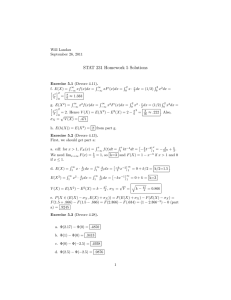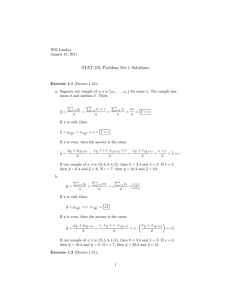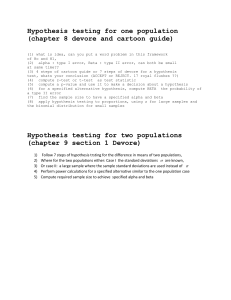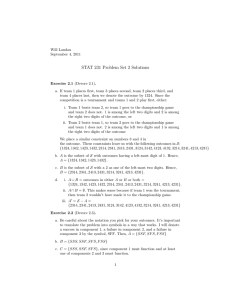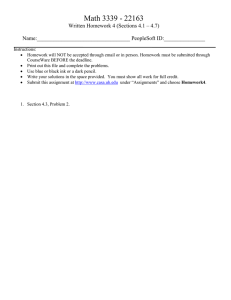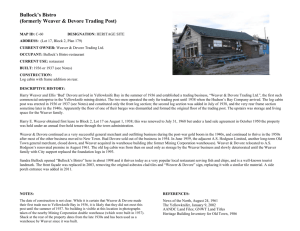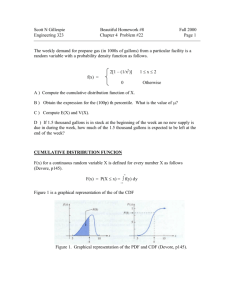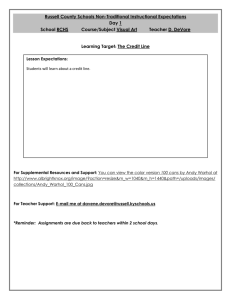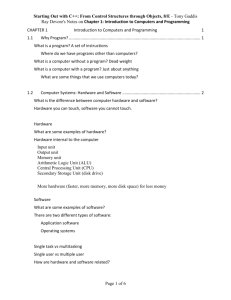Problem Set 3 Solutions
advertisement
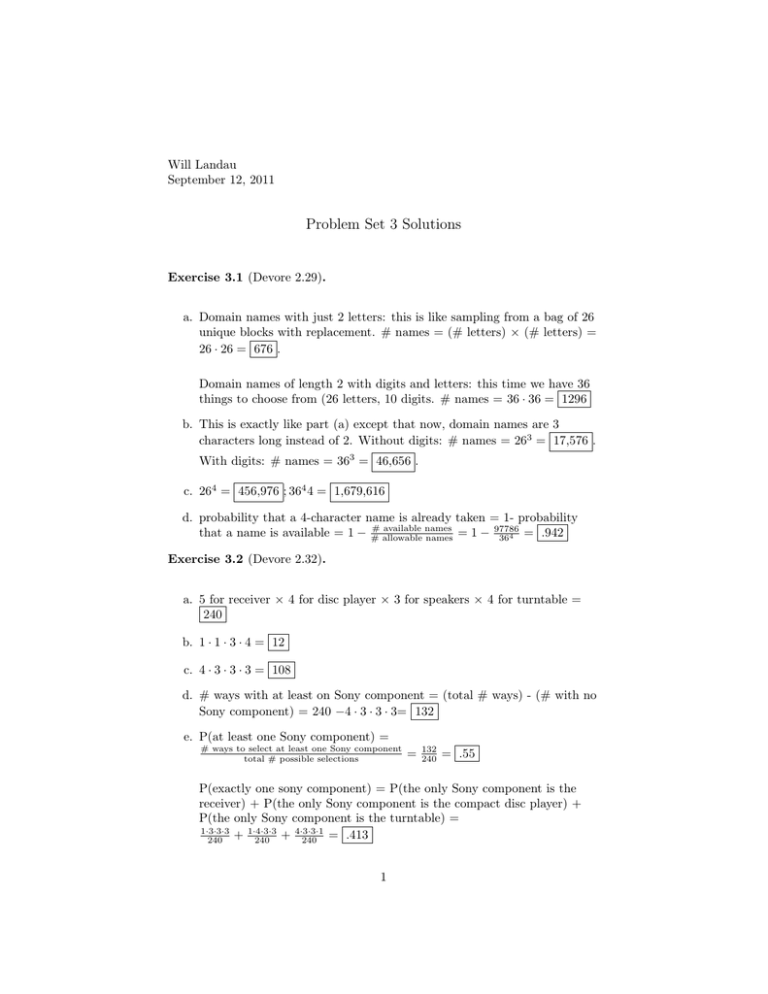
Will Landau
September 12, 2011
Problem Set 3 Solutions
Exercise 3.1 (Devore 2.29).
a. Domain names with just 2 letters: this is like sampling from a bag of 26
unique blocks with replacement. # names = (# letters) × (# letters) =
26 · 26 = 676 .
Domain names of length 2 with digits and letters: this time we have 36
things to choose from (26 letters, 10 digits. # names = 36 · 36 = 1296
b. This is exactly like part (a) except that now, domain names are 3
characters long instead of 2. Without digits: # names = 263 = 17,576 .
With digits: # names = 363 = 46,656 .
c. 264 = 456,976 ; 364 4 = 1,679,616
d. probability that a 4-character name is already taken = 1- probability
# available names
97786
that a name is available = 1 − #
allowable names = 1 − 364 = .942
Exercise 3.2 (Devore 2.32).
a. 5 for receiver × 4 for disc player × 3 for speakers × 4 for turntable =
240
b. 1 · 1 · 3 · 4 = 12
c. 4 · 3 · 3 · 3 = 108
d. # ways with at least on Sony component = (total # ways) - (# with no
Sony component) = 240 −4 · 3 · 3 · 3= 132
e. P(at least one Sony component) =
# ways to select at least one Sony component
total # possible selections
=
132
240
= .55
P(exactly one sony component) = P(the only Sony component is the
receiver) + P(the only Sony component is the compact disc player) +
P(the only Sony component is the turntable) =
1·4·3·3
4·3·3·1
1·3·3·3
240 + 240 + 240 = .413
1
Exercise 3.3 (Devore 2.34).
a.
25
5
=
25!
20!5!
= 53, 130
b. # ways = (# ways to select 2 with electrical defects) × (# ways to
6!
19!
select 3 without electrical defects) = 62 · 19
3 = 4!2! · 16!3! = 14535
c. P(at least 4) = P(exactly 4) + P(exactly 5) =
6
(19
(19)(6)
4 )·(1)
+ 5 25 0 = 0.6565
25
(5)
(5)
Exercise 3.4 (Devore 2.38).
a. P(select 2 75-W bulbs) =
(# ways to select 2 75-W bulbs)(# ways to select one non-75-W bulb)
total # ways to select 3 bulbs
=
(62)(91)
=
(15
3)
.2967
b. P(same rating) = P(select all 40-W) + P(select all 60-W) + P(select all
(43)
(5)
(63)
75-W) = 15
+ 3 + 15
= .0747
( 3 ) (15
)
(
3
3)
c.
(41)(51)(61)
= .2637
(15
3)
d. P(examine at least six bulbs) = P(draw 5 non-75-W bulbs) =
(4+5
5 )
= .042
(15
5)
Exercise 3.5 (Devore 2.71).
a. Since A and B are independent A0 and B 0 are independent (see page 83
just below Equation 2.7). Hence,
P (B 0 | A0 ) = P (B 0 ) = 1 − P (B) = 1 − .7 = .3
independence
b. P (A ∪ B) = P (A) + P (B) − P (A ∩ B)
P (A)P (B) = ..4 + .7 − .4 · .7 = .82
z}|{
=
P (A) + P (B) −
independence
P (A∩B 0 ∩(A∪B))
P (A∪B)
.4∗(1−.7)
=
.146
.82
c. P (A ∩ B 0 | A ∪ B) =
P (A)(1−P (B))
P (A∪B)
=
Exercise 3.6 (Devore 2.77).
2
=
P (A∩B 0 )
P (A∪B)
z}|{
=
P (A)P (B 0 )
P (A∪B)
=
a. Let p be the probability that a given rivet is defective. Then:
.2 = P (seam is defective)
= 1 − P (seam is good)
= 1 − P (all 25 rivets are good)
= 1 − P (rivet 1 is good) ∩ · · · ∩ P (rivet 25 is good)
= 1 − P (rivet 1 is good) · · · · · P (rivet 25 is good)
= 1 − (1 − p)25
Hence, p = .00889
b. Use the calculation above: if only 10% of the seams need reworking, then
.1 = 1 − (1 − p)25 , so p = .00421 .
Exercise 3.7 (Devore 2.78).
indep. identical valves
P(at least one valve opens) = 1-P(no valve opens)
1-P (a valve opens)5 = 1 − (1 − .95)5 = .99999969
z}|{
=
P(at least one fails to open) = 1-P(all valves open) = 1.955 = .2262
Exercise 3.8 (Devore 2.79).
Let O be the event that the older pump fails and N be the event that the
newer pump fails. We are given that P (O ∩ N 0 ) = .1 and P (O0 ∩ N ) = .05
(look carefully at the prompt. For each pump, it gives the probability that
ONLY that pump will fail). By the Law of Total Probability,
P (O) = P (O ∩ N ) + P (O ∩ N 0 ) = x + .1
P (N ) = P (O ∩ N ) + P (O0 ∩ N ) = x + .05
where x = P (O ∩ N ). Since the pumps fail independently of one another,
x = P (O ∩ N ) = P (O) · P (N ) = (x + .1)(x + .05)
⇒x2 − .85x + .005 = 0
We solve the above quadratic equation to get x = .0059 or x = .8441. Hence,
P (O ∩ N ) = .0059 or .8441 . Hopefully, the true system failure probability is
the smaller of the two, but we can’t know with the information given.
Exercise 3.9 (Devore 2.80).
Let Ci be the event that the i’th component FAILS. Then, P(system works) =
3
1-P(system fails) =
1 − P (C1 ∩ C2 ∩ (C3 ∪ C4 ))
= 1 − P (C1 )P (C2 )P (C3 ∪ C4 )
= 1 − P (C1 )P (C2 )[P (C3 ) + P (C4 ) − P (C3 ∩ C4 )]
= 1 − P (C1 )P (C2 )[P (C3 ) + P (C4 ) − P (C3 )P (C4 )]
= 1 − .1 · .1 · (.1 + .1 − .1 · .1)
= .9981
Exercise 3.10 (Devore 3.11).
a.
b.
c. P(at least six cylinders) = P (X ≥ 6) = .40 + .15 = .55
P(more than six cylinders) = P (X > 6) = .15
Exercise 3.11 (Devore 3.12).
a. P(everyone is accommodated) =
P (Y ≤ 50) = .05 + .1 + .12 + .14 + .25 + .17 = .83
4
b. P(not everyone is accommodated) = 1-P(everyone is accommodated) =
1-.83 = .17
c. P(first person on standby gets a seat) =
P (Y ≤ 49) = .05 + .1 + .12 + .14 + .25 = .66 . Assuming the first and
second people on standby actually take seats if they are available,
P(third person on standby gets a seat) =
P (Y ≤ 47) = .05 + .1 + .12 = .27 ,
Exercise 3.12 (Devore 3.13).
a. P (X ≤ 3) = p(0) + p(1) + p(2) + p(3) = .10 + .15 + .20 + .25 = .70
b. P (X < 3) = P (X ≤ 2) = p(0) + p(1) + p(2) = .45
c. P (X ≥ 3) = p(3) + p(4) + p(5) + p(6) = .55
d. P (2 ≤ X ≤ 5) = p(2) + p(3) + p(4) + p(5) = .71
e. The number of lines not in use is 6 − X, so we calculate P (2 ≤ 6 − X ≤
4) = P (−4 ≤ X − 6 ≤ −2) = P (2 ≤ X ≤ 4) = p(2) + p(3) + p(4) = .65
f. P (6 − X ≥ 4) = P (6 ≥ X + 4) = P (2 ≥ X) = p(0) + p(1) + p(2) = .45
Exercise 3.13 (Devore 3.22).
F (0) = P (X ≤ 0) = .1
F (1) = P (X ≤ 1) = .1 + .15 = .25
F (2) = P (X ≤ 2) = .1 + .15 + .2 = .45
F (3) = P (X ≤ 3) = .1 + .15 + .2 + .25 = .7
F (4) = P (X ≤ 4) = .1 + .15 + .2 + .25 + .2 = .9
F (5) = P (X ≤ 5) = .1 + .15 + .2 + .25 + .2 + .06 = .96
F (6) = P (X ≤ 6) = .1 + .15 + .2 + .25 + .2 + .06 + .04 = 1
Hence:
5
And:
a. P (X ≤ 3) = F (3) = .70
b. P (X < 3) = P (X ≤ 2) = F (2) = .45
c. P (3 ≤ X) = 1 − P (X ≤ 2) = 1 − F (2) = 1 − .45 = .55
d. P (2 ≤ X ≤ 5) = F (5) − F (1) = .96 − .25 = .71
Exercise 3.14 (Devore 3.23).
6
a. P (X = 2) = F (2) − F (1) = .39 − .19 = .2
b. P (X > 3) = F (6) − F (3) = 1 − .67 = .33
c. P (2 ≤ X ≤ 5) = F (5) − F (1) = .97 − .19 = .78
d. P (2 < X < 5) = F (4) − F (1) = 92 − .39 = .53
Exercise 3.15 (Devore 3.29).
a. E(X) =
P
x·p(x) = (1)(.05)+(2)(.1)+(4)(.35)+(8)(.4)+(16)(.1) = 6.45
P
b. V (X) = (x − E(X))2 · p(x) = (1 − 6.45)2 (.05) + (2 − 6.45)2 (.1) + (4 −
6.45)2 (.35) + (8 − 6.45)2 (.4) + (16 − 6.45)2 (.1) = 15.6475
√
c. σX = X = 3.9557
P
d. First, we compute E(X 2 ) = x2 · p(x) =
(12 )(.05) + (22 )(.1) + (42 )(.35) + (82 )(.4) + (162 )(.1) = 57.25. Next, we
use the shortcut formula to calculate
V (X) = E(X 2 ) − [E(X)]2 = 57.25 − 6.452 = 15.6475
ExerciseP3.16 (Devore 3.31).
E(Y ) = y ∗ p(y) = (45)(.05) + (46)(.1) + (47)(.12) + (48)(.14) + (49)(.25) +
(50)(.17) + (51)(.06) + (52)(.05) + (53)(.03) + (54)(.02) + (55)(.01) = 48.84
P
E(Y 2 ) = y 2 p(y) = (452 )(.05)+(462 )(.1)+(472 )(.12)+(482 )(.14)+(492 )(.25)+
(502 )(.17)+(512 )(.06)+(522 )(.05)+(532 )(.03)+(542 )(.02)+(552 )(.01) = 2389.84
Using the shortcut formula for variances,
V (Y ) = E(Y 2 ) − [E(Y )]2 = 2389.84 − 48.842 = 4.4944 . Also,
p
σY = V (Y ) = 2.12
Now, if a value y is within one standard deviation of the mean of Y , then
E(Y ) − σY ≤ y ≤ E(Y ) + σY = 48.84 − 2.12 ≤ y ≤ 48.84 + 2.12 = 46.72 ≤ y ≤
50.96. Since y only takes on the integers 45 through 55, this means
47 ≤ y ≤ 50. Hence, P (Y falls within one standard deviation of its mean) =
P (47 ≤ Y ≤ 50) = p(47) + p(48) + p(49) + p(50) = .12 + .14 + .25 + .17 = .68
Exercise 3.17 (Devore 3.35).
If the store owner stocks 3 copies, then the profit h3 (x) (sales revenue - cost) is
4x − 2 ∗ 3 = 4x − 6 for x = 1, 2, 3. Since the owner can only sell as much as he
stocks, h3 (x) = 4 ∗ 3 − 2 ∗ 3 = 6 for x = 4, 5, 6. Similarly, if the owner stocks 4
copies, then the profit h4 (x) is 4 ∗ x − 2 ∗ 4 = 4x − 8 for x = 1, 2, 3, 4 and
4 ∗ 4 − 2 ∗ 4 = 8 for x = 5, 6. To summarize:
7
x
p(x)
h3 (x)
h4 (x)
1
1/15
-2
-4
2
2/15
2
0
3
3/15
6
4
4
4/15
6
8
5
3/15
6
8
6
2/15
6
8
P
If Y = h3 (X), then E(Y ) = h3 (x) · p(x) =
(−2)(1/15) + (2)(2/15) + (6)(3/15) + (6)(4/15) + (6)(3/15) + (6)(2/15) = 4.933
P
If Z = h4 (X), then E(Z) = h4 (x) · p(x) =
(−4)(1/15) + (0)(2/15) + (4)(3/15) + (8)(4/15) + (8)(3/15) + (8)(2/15) = 5.333.
Since E(Y ) < E(Z), the owner should probably stock 4 copies instead of 3.
Exercise 3.18 (Devore 3.36).
Let H(X) be the company’s profit without the premium: D(X) − X, where D
is the deductible. Since the consumer pays no deductible if there is no accident
and pays the full deductible if total damage is at least $500,
p(x)
x
H(x)
.8
0
0
.1
1000
-500
.08
5000
-4500
.02
10000
-9500
E[H(X)] = (0)(.8) + (−500)(.1) + (−4500)(.08) + (−9500)(.02) = −600.
Hence, if the company wants a profit of $100, it should charge an annual
premium of $700
Exercise 3.19 (Devore 3.39).
E(X) = (1)(.2) + (2)(.4) + (3)(.3) + (4)(.1) = 2.3
E(X 2 ) = (12 )(.2) + (22 )(.4) + (32 )(.3) + (42 )(.1) = 6.1
V (X) = E(X 2 ) − E 2 (X) = 6.1 − 2.32 = .81
The number of pounds left is H(X) = 100 − 5X, so
E[H(X)] = E(100 − 5X) = 100 − 5E(X) = 100 − 5 ∗ 2.3 = 88.5 and
V [H(X)] = V (100 − 5X) = 52 V (X) = 52 ∗ .81 = 20.25
8
